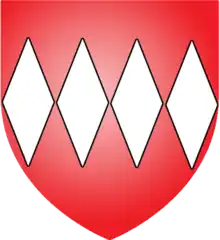De Carteret family
The de Carteret family was perhaps the greatest of the patrician families of the Channel Islands. Their influence on the Island would last from the 10th century until the present time.

Origins
The family originated from Normandy where their ancestor Guy de Carteret would be the first Lord of the Barony of Carteret in Normandy. The family would side with William the Conqueror in the Norman conquest. Years later Renaud de Carteret I would return from First Crusade and take the parish of St Ouen by force, establishing the family's presence in the Channel Islands. A descendant of Renaud de Carteret I named Hellier de Carteret colonised the island of Sark and would become the first of the Seigneurs of Sark. During the English Civil War, the Great-Grandson of Hellier de Carteret, Sir George Carteret would become a prominent Royalist and Friend to King Charles II, he was made Vice-Chamberlain of the Household, Treasurer of the Navy, Member of Parliament and made a Baronet.[1][2] He was also granted lands in the Carolinas and in what eventually became the state of New Jersey. His descendants later became Barons Carteret and the Earls of Granville.[3]
Their ancestral seat is Saint Ouen's Manor, Jersey, still today owned by persons of that name.

Notable Members
Members of the family included:
- John Carteret, 2nd Earl Granville, 7th Seigneur of Sark, KG, PC
- Robert Carteret, 3rd Earl Granville
- Vice Admiral Sir George Carteret, 1st Baronet (1610-1680)
- Sir Philip Carteret, FRS
- Henry Carteret, 1st Baron Carteret
- Sophia Carteret (wife of Prime Minister William Petty, 2nd Earl of Shelburne)
- George Carteret, 1st Baron Carteret
- Sir Philip Carteret, 1st Baronet
- Sir Philip Carteret, 2nd Baronet
- Sir Charles Carteret, 3rd Baronet
- Renaud de Carteret III (1140-1214)
- Philippe de Carteret, 2nd of St Ouen (1152-11xx)
- Renaud de Carteret I (1063-1125)
- Renaud de Carteret V (1316-
- Hellier de Carteret (1563-1578)
- Philippe de Carteret II (1584–1643)
- Philippe de Carteret I (1552–1594)
- Jason De Carteret (19xx-)
- Sir Francis de Carteret Attorney-General of Jersey
- George William de Carteret (1869 Jersey-4 September 1940)
- Cecil de Carteret (1886–3 January 1932)
- Philip de Carteret, 8th of St Ouen (14xx-1500)
- Philippe de Carteret III (1620-between 1663 and 1675))
- Philippe de Carteret IV(1650-1693)
- Charles de Carteret (1679-1715)
- Rear-Admiral Philip Carteret, Seigneur of Trinity
- Sir Philip Carteret Silvester
- Capt. William George Square De Carteret (Part of the body recovery mission from the Titanic, as captain of SS Minia)

See also
References
- Payne, James Bertrand (1859–1865). Armorial of Jersey : being an account, heraldic and antiquarian, of its chief native families, with pedigrees, biographical notices, and illustrative data; to which are added a brief history of heraldry, and remarks on the mediaeval antiquities of the island. University of California Libraries. [Jersey].
- Balleine, G.R (1976). All for the King: The Life story of Sir George Carteret (1609-1680). Jersey Channel Islands: Société Jersiaise. ISBN 0901897108.
- "Burke's Peerage". burkespeerage.com. Retrieved 2020-11-22.